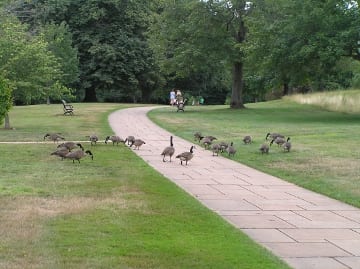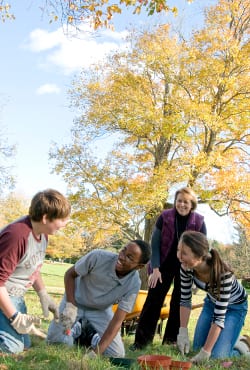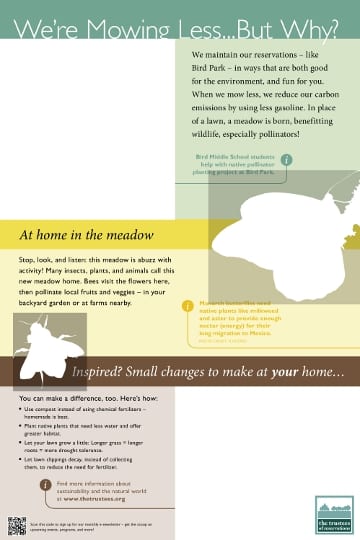by Russ Hopping
Parks and other cultural landscapes require careful planning and stewardship to make them special places for visitors. The natural world includes equally special and unique places that may require our care as well. The lines are not always clear between what is natural and what is cultural, however. Indeed in many, perhaps even all, locations the two can overlap and can be compatible. For example, a park originally designed for the public to recreate and to find a respite from the daily grind may also provide habitat for a variety of plants and animals. The Francis William Bird Park (Bird Park) in Walpole is just such a place and perhaps a perfect example of how nature and designed landscapes coexist.
Originally designed by landscape architect John Nolen in 1925 as a gift to the community from the Bird Family, the 89-acre Park became a property of The Trustees of Reservations in 2003. Nolen believed landscape design could be a tool for societal improvement; Bird Park’s network of pathways (more than 3 miles) and water courses were designed to offer the public an easy introduction to their natural surroundings. As the Trustees set about planning for the park’s future it was important to honor this history but also to incorporate sustainable practices to carry the park into an ever changing future.

There are many acres of lawn at Bird Park and miles of paths for walking. Note areas adjacent to walkways are maintained as lawn, but areas further away are maintained as meadows where the grass is allowed to grow taller.
Finding Greener Opportunities
As a land trust, The Trustees is surely “green,” but we’re always looking for ways to reduce our ecological footprint to achieve more sustainable landscapes and ultimately, healthy communities where people have access to clean water, clean air, healthy food, and an environment that is resilient. The vast lawns at Bird Park provided us with an opportunity to improve the landscape for both our human and non-human residents by reducing the amount of lawn area. By mowing less – seven acres less, to be exact – we’re reducing greenhouse gases and providing better habitat. In place of well-maintained lawn (which took lots of time and gasoline) meadows that are mowed once a year now hum with pollinators visiting native wildflowers and visitors experience a more diverse and colorful park.
The mow-less areas are scattered throughout the park and incorporate various soil types. Well-drained knolls now support plants adapted to xeric growing conditions such as little bluestem grass (Schizachyrium scoparium) while wet meadow plants including Joe-Pye weeds (Eupatorium spp.) and Boneset (E. perfoliatum) now prosper in low areas adjacent to the waterways. While some wildflowers planted themselves from nearby seed sources others required help. To assist The Trustees with this transformation, students from the nearby Bird Middle School help annually by growing wildflowers, such as orange milkweed (Asclepias tuberosa) and wild lupine (Lupinus perennis), to plant in the meadows to increase habitat diversity and aesthetics.

Students and their teacher from the Bird Middle School plant wildflowers at Bird Park that they grew from seed.
Community Involvement
More recently, students from the Norfolk County Agricultural High School grew hundreds of wildflowers to supplement the annual plantings by the Bird Middle School students. Over time, these areas will support an even greater variety of flowers, from spring through fall, providing pollinators with a steady source of nectar and pollen, butterflies with host plants, nesting bluebirds with more insects to feed their young while visitors get to witness an ever changing mosaic of color through the seasons.
While habitat benefits are exciting, the energy savings are equally important. By reducing our mowing on seven acres The Trustees now prevents approximately 1-meteric ton of CO2 from entering the atmosphere a year and saves nearly 50 hours of staff time. Additional CO2 savings have been achieved by switching to propane powered mowers for all mowing at the Park.
Telling the Story
Change can be difficult to accept. Some visitors may at first object to the longer grass, misinterpreting it to mean the area is no longer being cared for. Quite the contrary, but who would know without explanation. Telling this story has been an important component at Bird Park, and visitors can learn about our greening efforts and are encouraged to apply them at home through interpretive panels.
Could less mowing at Bird Park be a model for backyards and public spaces with vast areas of lawn that require a lot of maintenance? We hope so. Rest assured there is a place for lawn and The Trustees will continue to maintain areas of lawn at Bird Park – sustainably – but collectively small changes in our yards and community spaces will make healthy homes for birds, bees, and butterflies and help to make our planet cooler for everyone. Ultimately, even small efforts to mow less can bring people closer to their natural surroundings and rebuild a connection to nature.
For more information on Bird Park and The Trustees sustainable management, please visit http://www.thetrustees.org/places-to-visit/greater-boston/bird-park.html.
About the Author
Russell Hopping is the Ecology Program Director for The Trustees of Reservations. He has a master’s degree in Environmental Biology from Antioch New England Graduate School and a bachelor’s degree in Human Ecology from the College of the Atlantic. He has worked for The Trustees of Reservations since 1997. Russ oversees the documentation and stewardship of ecological resources at The Trustees’ more than 26,000 acres. He may be reached at 978-840-4446 x 1927 or at rhopping@ttor.org.



